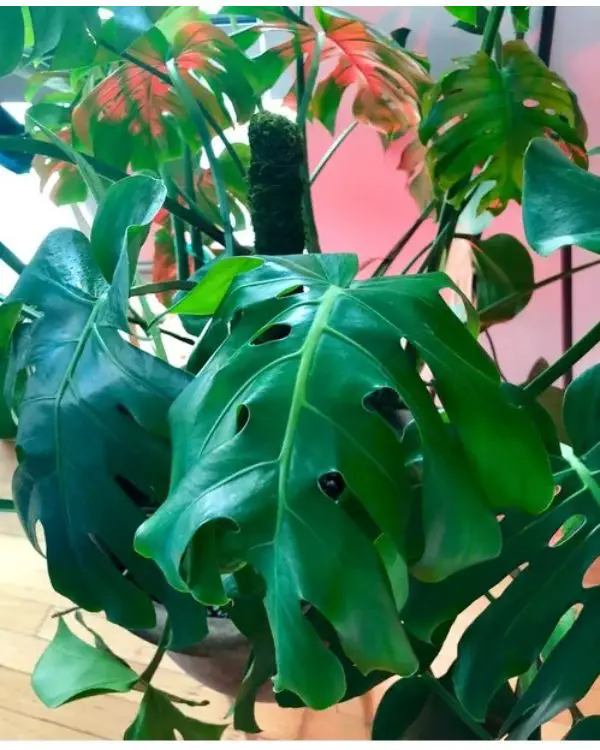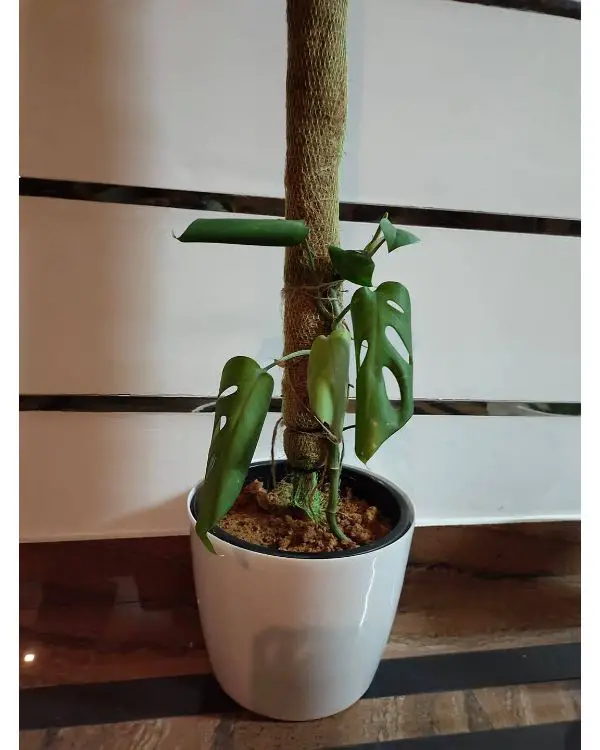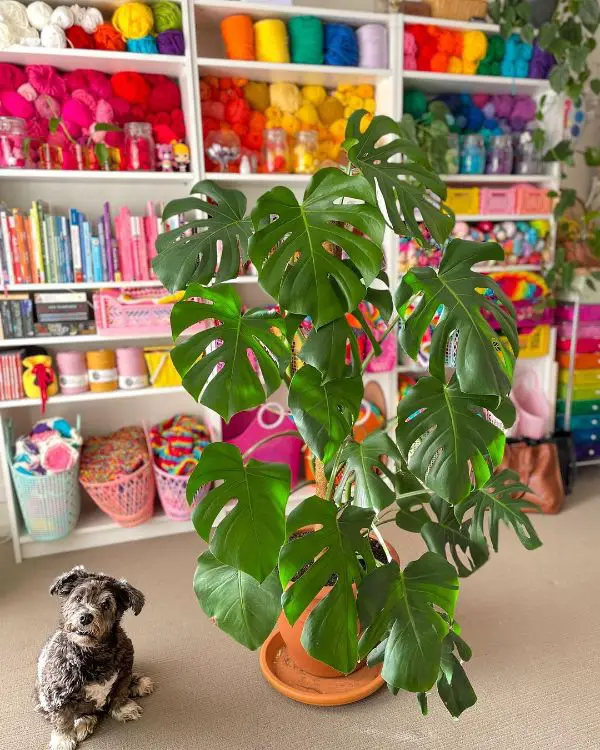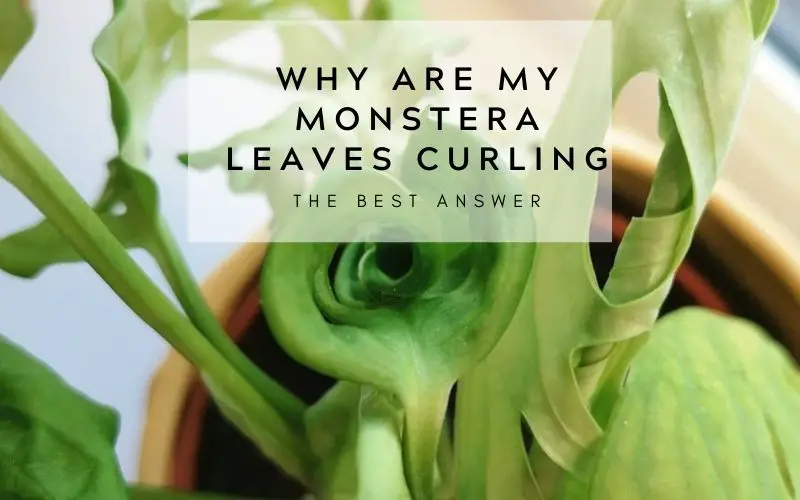If you want to know the reason why Monstera leaves curling? Dig Nursery will help you learn the causes and solutions to fix the problem below. In taking care of Monstera plants at home, you may encounter many different issues, then, please immediately read the excellent articles on our website.
What Is Monstera Leaf Curl and How Does It Work?
Monstera Deliciosa leaves curling is a condition that can affect your plant’s leaves, causing them to curl up and become distorted. While it’s not life-threatening, it can be unsightly and may even impede the plant’s ability to photosynthesize properly. A monstera leaf can curl in various ways, which might reveal information about the root problem.
Monstera Leaves Curling Inwards
If the leaves of your monstera are curling inwards or upwards toward the top of the leaf, it might be a sign of a watering problem, a lack of humidity, or an insect infestation.
Monstera Leaves Curling Under
Monstera leaves may curl down at the bottom of the leaf for many of the same reasons, albeit this is often more suggestive of heat stress or underwatering if the leaf lacks turgor pressure. This might be the case if the leaves are thin, limp, or drooping.
Monstera Leaves Crinkling
Underwatering or low humidity may cause crinkled, brittle leaves, particularly if they’re accompanied by dry or browning margins.
If you see any of these symptoms, such as puckering or curling leaves under or upward, here are some probable explanations and how to find out why your monstera is upset!

Why are my Monstera leaves curling? How to Fix
There are many reasons, including improper lighting, too high or too low temperature, low humidity, incorrect watering, and too many minerals in the water.
Monstera leaves are curling due to improper lighting
Most Monstera varieties require bright, indirect light to thrive, and too much direct sun will scorch their leaves. If your Monstera’s leaves are curling, it’s a sign that it’s not getting enough light.
Solutions:
If you move Monstera back into the shade, the leaves should pop out within a day or two. It will help if you do not keep them in a sunny window but still ensure there is light for photosynthesis, for example, under a larger canopy or behind a sunblock.
Not sure how much light to use for your Monstera? Here is the answer: How much light does a Monstera need
The temperature is too high or low
If you think your Monstera is getting enough light but its leaves are still curling, it could be a sign of the temperature is not appropriate. If the temperature is too high or low, it can cause the leaves to curl in an attempt to conserve moisture. Monsteras prefer warm, humid conditions, so if the air is too dry, it can also cause the leaves to curl. Monsteras are native to tropical rainforests, so they need ample humidity to thrive.
Solutions:
If it is hot, the leaves will dry out and fade. The best temperature for Monstera is between 16-29°C. But if the leaves are curling, try turning the air conditioner up to 24 °C. Monitor the plant’s condition for a few days and continue to adjust the temperature until the curling leaves open up and begin to harden. Monstera should not be placed in front of fans or under air conditioners.
Low humidity causes the leaves of Monstera to curl
While Monsteras are typically very resilient plants, they are native to tropical environments where the humidity is high. When the humidity drops, the leave begin to experience stress and will start to curl in order to prevent themselves from losing too much water.
Solutions:
The best way to solve this problem is to increase the humidity around your plant. This can be done by misting the leaves on a daily basis or placing the pot on a pebble tray.
Monstera has curled leaves due to overwatering
If you see your Monstera’s leaves curling, it’s a sign that the plant is overwatered. This can be caused by several different factors, including fungal growth, nutrient deficiencies, and even insect infestations. If you notice that your Monstera leaves are beginning to curl, it’s important to take action immediately. Otherwise, your plant may become seriously damaged or even die.
Solutions:
- First, allow the soil to dry out completely before watering again.
- Then, increase the amount of drainage in the pot by adding more perlite or by using a pot with drainage holes.
- Finally, make sure you’re only watering when the top inch of soil is dry.
Underwatering
Monsteras are native to tropical climates, where they receive regular rainfall. As a result, they are used to high levels of moisture and will start to experience stress when they are deprived of water. Curling leaves is one of the ways that a Monstera will signal that it is thirsty.
Solutions:
If you notice that your plant’s leaves are starting to curl, try increasing the frequency of your watering schedule. In general, Monsteras should be watered once a week, but they may need more frequent watering during periods of high heat or low humidity.
Too many minerals in the water
Tap water often has a high salt content that will cause your Monstera leaves to wilt and fade. It shows up as leaves with yellow edges, and you can even see salt build up on the soil’s surface.
Solutions:
Rainwater and bottled spring water are the greatest solutions for giving your plants the best possible care. They will be harmed by any water that contains sugar or salt!

Insect Infestation
A few insects have been known to attack Monstera and inflict injury. It is nearly difficult to completely eliminate bugs, no matter how hard you try. This article, on the other hand, will give remedies to common Monstera problems.
Spider mites, thrips, and aphids are among the most common sap-sucking insects you’ll find on your Monstera. Curling leaves come from these insects sucking the nutrient-rich sap from the leaves.
Because all of these insects are so little, you’ll need to be extremely vigilant in order to spot them and take action. Look for them on both the top and bottom of the leaves.
Solutions:
To get rid of insects on houseplants, I choose a nonchemical or organic technique. This type of soft-bodied bug responds well to dishwashing liquid detergent, rubbing alcohol, and neem oil. If there is a severe infestation, the chemical approach should be used.
Compacted Soil or Wrapped Roots make leaves curl
If your Monstera’s roots are firmly wrapped or the dirt in the pot is hard and compacted, it may show signs of dryness, such as crispy brown spots and curled leaves, as well as signs of overwatering, such as dark brown spots and mushy stems.
This is due to the fact that compacted soil does not readily absorb water (leading to underwatering) or drain properly once it does (which leads to overwatering and even root rot). Furthermore, roots that are wrapped may find it difficult to receive water and nutrients from the soil.
Solutions:
Repotting your Monstera into fresh, well-aerated soil and a clean container with drainage that’s 2-3 inches bigger than the root ball is the best approach.
If you do not know how to repot Monstera, please refer to the following article: When to repot Monstera? How to replant houseplants
Ways to make Monstera green and healthy again
There are some tips to help you get Monstera green and healthy again. They add nutrients to the soil, repotting plants, moderate watering, and changing the position of the pot, adding fertilizer.
Add nutrients to the soil
Are you wondering why your Monstera is wilting, even though you have chosen to buy the best one?. It will help if you ensure the earth is full of nutrients to grow plants even in the lowest conditions.
Instead of just using regular soil, why don’t you try the following method?
Prepare ingredients: Banana peel, coffee grounds, eggshell, and blender. You put all the above ingredients in a blender, add a little filtered water, and then start pureeing to form a homogeneous mixture. After you have obtained a paste, you can use it to mix it with the potting soil, or if you don’t have time, scoop the mixture with a spoon and apply it on the ground.
These are ingredients that are easy to find in your home. They contain many nutrients necessary for root growth and help plants grow better. Apply this bonsai care and feel the difference! You will see the magic happen to your bonsai pots.
Repotting plants
If you have made an effort to improve the soil, why not change the pot? Replacing a new pot with a larger size containing more new soil is also a way to help you solve the situation of newly planted trees with wilted leaves. Larger pots will help the roots grow better, longer, and broader, from which the plant can absorb nutrients more completely.
Moderate watering for Monstera
Many people use Monstera to decorate their homes. However, are you sure you have a good understanding of each type of Monstera? Each of them will need a certain amount of water. Not every withering plant leaves due to a lack of water. When you intend to plant decorative Monstera on the balcony, you should learn them first to avoid dying. Newly planted Monstera with wilted leaves can be caused by watering too much or watering too little.
Over-watering will cause oxygen deprivation and root rot, causing young leaves to pale and turn yellow. You just need to dig the soil to provide oxygen to save the tree. If the leaves are dry due to lack of water, the leaves will turn yellow, and the leaf surface will be wrinkled and drooping, no longer shiny, the petioles will be soft, then gradually yellow and spread all over the leaf. All you need to do is water the plants and lightly dig the soil for oxygen if possible.

Change the position of the pot to help Monstera get enough light
In some cases, the leaves wilt due to the high air temperature, especially during the hot season. At this time, the tree is prone to drying out due to the intensity of light being too strong and harsh, making the amount of water under the soil not enough to “irrigate” the plants. How to fix newly planted Monstera with wilted leaves is very simple. It would help if you moved the tree to a shady place.
You can also “cool” the plant by spraying water all over the surface of the leaves, branches, stems, and roots, then letting the water dry on its own. Besides, Monstera doesn’t like the sun, and you need to put them in a well-lit place without doing anything else.
Related Post: Why does my Monstera have brown spots on leaf? How to fix it
Add fertilizer for Monstera
The lack of fertilizer will also cause the leaves to become yellow and wither, stunted, and even unable to flower and produce leaves. You need to buy some fertilizer and periodically feed the plants. To buy the correct type of fertilizer for every kind of plant, you should consult the seller of fertilizers.
When you fertilize, it is essential that you only apply the right amount of fertilizer at each care. An excess of manure will also cause the leaves to burn and turn yellow. After fertilizing, work hard to water to create the necessary moisture to dissolve and seep into the soil. Don’t forget to follow us on our website, DIG Nursery, to get more information about why are my Monstera leaves curling and take care of Monstera.


